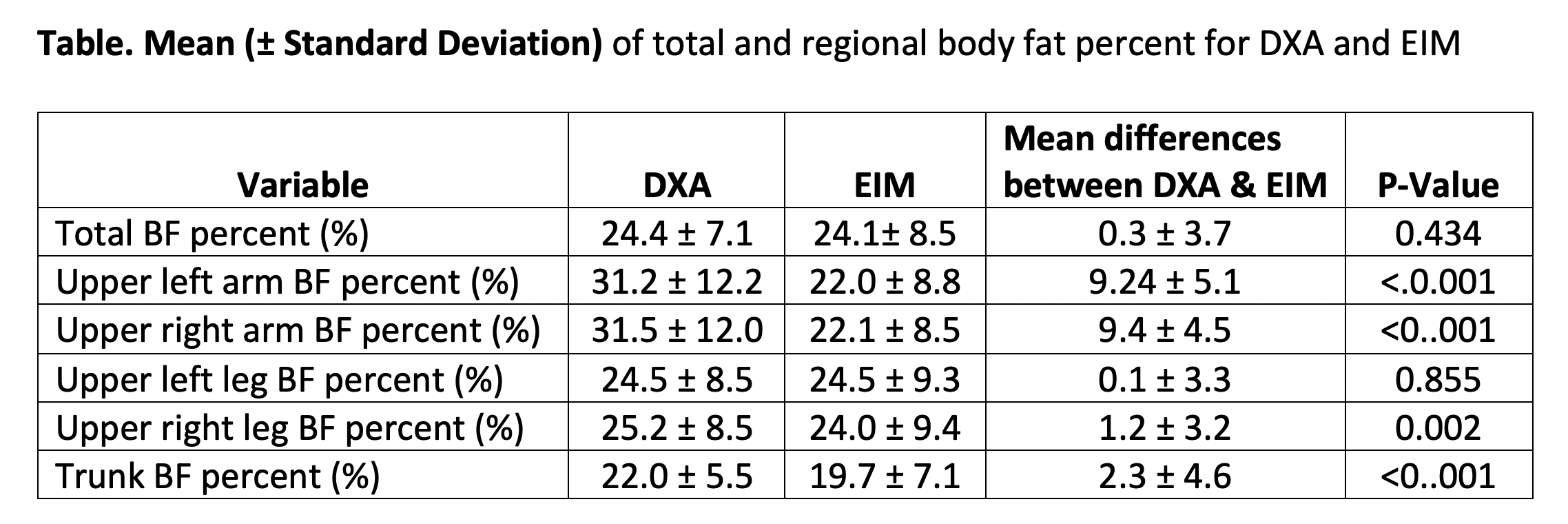New methods of measuring body composition are constantly being developed, however not all of these methods give the user valid measures. My laboratory often undertakes studies to examine the validity and reliability of these new methods of determining body composition. One of these newer body composition methods is electrical impedance myography (EIM), which utilizes a low amplitude electrical current to measure percent body fat. Although EIM sounds very similar to bioelectrical impedance analysis (BIA), EIM sends an electrical current through each muscle, while BIA sends an electrical current through the entire body to estimate percent body fat. Because EIM sends a signal through each muscle, it is possible to determine regional, as well as, total percent body fat. Although EIM has been available for a while, a hand-held EIM device (Skulpt Chisel, Skulpt, Inc.) was recently introduced to the market, providing a lower-cost method to determine regional as well as total body composition outside of a laboratory setting. Therefore, we decided to determine the validity of a handheld EIM device to measure regional as well as total body position. We compared the results of the EIM device against dual X-ray absorptiometry (DXA), which is considered the “gold standard” for determining body composition. It is important to point out that EIM is a two-component method of determining body composition, so you will only be able to determine fat mass and fat-free mass, while DXA is a three-component method of determining body composition, so you not only measure fat mass, you also measure lean skeletal muscle mass and bone mass. For this study, we compared fat-free mass and fat mass measures from the EIM device to these same measures using DXA. The full results of this research can be found in an article that recently appeared in the American Journal of Human Biology (Czeck et al., 2020).
Design of the study
Sixty-nine male and female (33 males/36 females) college-age (age = 21.9± 2.0 years) individuals participated in this study. Each participant's total and regional (i.e., upper arms, upper legs, trunk) percent body fat was estimated using EIM and DXA. Metallic markers were used to delineate regional boundaries for analysis (see photo), including upper arms (biceps/triceps), upper legs (quadriceps/hamstrings), and trunk (abdominal region/low back region). Paired t-tests assessed the accuracy of percent body fat values estimated from EIM in comparison to percent body fat measured by DXA.

Results of the study
The results of this study can be found in the table below. We observed that the handheld EIM device used in this study had significantly lower regional percent body fat values for upper left arm, upper right arm, upper right leg, and trunk. However, no significant differences were observed in total body percent fat or upper left leg regional percent fat between the two devices.

Abbreviations: BF, body fat; DXA, dual X-ray absorptiometry; EIM, electrical impedance myography.
What does it all mean?
In comparison to DXA, the handheld EIM device (Skulpt Chisel, Skulpt, Inc.) examined in this study produced similar total body percent fat measurements, while regional measures of percent body fat were significantly underestimated in most regions. These observations suggest EIM may provide a convenient and less costly method by which to estimate total percent body fat when DXA is unavailable. However, more research is needed to fully assess EIM's total and regional percent body fat measure accuracy in other populations. In addition, it should be pointed out EIM does not allow for the determination of bone mineral density as is possible with DXA.
References
Czeck MA, Raymond-Pope CJ, Prescott E, Bisch KL, Dengel DR: Body fat percent assessment between electrical impedance myography and dual X-ray absorptiometry. American Journal of Human Biology 2020;32:e23330. https://doi.org/10.1002/ajhb.23330.
About the Author
Donald Dengel, Ph.D., is a Professor in the School of Kinesiology at the University of Minnesota and is a co-founder of Dexalytics. He serves as the Director of the Laboratory of Integrative Human Physiology, which provides clinical vascular, metabolic, exercise and body composition testing for researchers across the University of Minnesota.